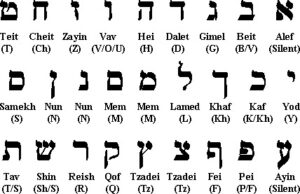Aramaic Word Study – Happiest – Tovihun – Teth Vav Beth Hei Vav Nun
Jeremiah 2:31: “O generation, see ye the word of the LORD. Have I been a wilderness unto Israel? a land of darkness? wherefore say, my people, We are lords; we will come no more unto thee?”
John 20:29: “Jesus saith unto him, Thomas, because thou hast seen me, thou hast believed: blessed [are] they that have not seen, and [yet] have believed.”
 I have read Jeremiah many times in my half-century of studying God’s Word. I have studied this passage but it wasn’t until I meditated on it that I noticed something strange. Maybe, you’ve seen it right away, but I didn’t. My question is: How can you see the word of the Lord? This is no mistake, the word in Hebrew is ra’ah which is seeing with the naked eye or seeing with spiritual eyes. Even with spiritual eyes, what do you actually see in the spirit? The real question is why did not the prophet use the word shama’ which is your word for hearing and is almost always used when people are exhorted to hear the Word of the Lord.
I have read Jeremiah many times in my half-century of studying God’s Word. I have studied this passage but it wasn’t until I meditated on it that I noticed something strange. Maybe, you’ve seen it right away, but I didn’t. My question is: How can you see the word of the Lord? This is no mistake, the word in Hebrew is ra’ah which is seeing with the naked eye or seeing with spiritual eyes. Even with spiritual eyes, what do you actually see in the spirit? The real question is why did not the prophet use the word shama’ which is your word for hearing and is almost always used when people are exhorted to hear the Word of the Lord.
Looking at what our modern translations do with this is not encouraging. The NIV says to consider the Word of the Lord, the NLT says to listen, the ESV says behold, NASB uses the English word heed, CSB offers to pay attention and the Darby Bible says to mark the Word. Only the KJV and a couple of other translations I have examined used the word see.
I am not saying these modern translations are wrong. They are using proper linguistics and pure logic tells you people did not have computerized projectors 3,000 years ago where verses of the Bible showed up on one or two screens on a platform. In the 21st Century it is possible to see the Word of God, but not 3,000 years ago. So, Bible translators have every right to render this as listen, behold, heed pay attention, or mark the Word.
Yet, before we jump to the conclusion that the text really meant for us to understand this as hearing even though it uses the word see, you might search to find an explanation as to why Scripture uses the word ra’ah rather than shema. I found a great explanation that I actually believe. It is in the Mechilta which is an exegesis of the book of Exodus. Jewish tradition teaches that during the prophecies of Jeremiah God ordered that the jug of manna be removed to give a visual demonstration of the Word of the Lord.
Ex 16:32: “And Moses said, This [is] the thing which the LORD commandeth, Fill an omer of it (manna) to be kept for your generations; that they may see the bread wherewith I have fed you in the wilderness, when I brought you forth from the land of Egypt.” God commanded Moses to take an omer of manna, that is about three pounds, and keep it for future generations so that God could show them or allow them to see how He sustained their ancestors in the desert. Aaron collected some manna and put it in a clay jar which was placed inside the Holy of Holies. Now we know from Scripture that manna turns to liquid after a day and becomes just water which evaporates. So, God was performing a miracle of preserving this manna for 500 years. Christian tradition says it was placed inside the Ark of the Covenant and Jewish tradition says it was placed beside the Ark. I am sure our soul salvation does not depend upon whether we believe it was inside the Ark or beside it.
According to the Talmud in Yoma 52b and the Mishnah in the Laws of the Holy Temple 4:1, when King Solomon built the Holy Temple he knew it was destined to be destroyed so he built a place in which to hide the Ark. This was a tunnel with deep winding passageways where the jar of manna and the Ark would eventually reside 22 years before the destruction of the First Temple. King Josiah, a Godly king, was said to have hidden the jug of manna together with the Ark in this special hidden passage. According to tradition, it will remain hidden until the day of the Messiah. So those of you into Bible Prophecy, if some archaeologist discovers this hidden tunnel and finds an Ark and clay jar with three pounds of manna, I will be willing to concede that the return of Jesus has arrived.
But, let’s back up here. Did Jeremiah really command that jar of manna to be brought out for people to see? I believe he did. After all, that was the purpose of keeping a jar of manna so future generations would witness, see the Word of the Lord in manna that survived for centuries, would see that God will sustain his people like He did centuries earlier.
I believe just before Jesus returns that tunnel will be found and the evidence of manna three thousand years old, all fresh and ready to eat will be God’s last and final call to repentance. It will be His last call to believe. He will provide physical proof of his ability to sustain His people and perhaps spark the final revival for many will turn to Him after ra’ah “seeing” His Word.
For you and I we do not need to see 3,000-year-old manna still fresh and ready to eat to believe for we are believing without seeing and Jesus said that we are blessed. In John 20:21 Jesus said: “Blessed are those who have not seen and believed. Does this mean that Thomas was not blessed because he needed to see something tangible to believe? Does that mean that everyone who has had a miracle or signs from God to help their belief are not blessed? The word in Aramaic for blessed is not barak as I thought it would be but tovihun which means happy but this word is in an intensive form in the Aramaic so it really means the happiest.
Some people have received signs from God and visions. Oh, how we love to hear their stories and how we envy them for these experiences. How we wish we had such miracles and testimonies to increase our faith. But, alas, most of us will never have such testimonies. However Jesus promised that we will be blessed, that is we will be the happiest because our faith is not dependent upon signs and wonders, our faith is based upon our choice to believe. Some people live from sign to sign, wonder to wonder. They travel great distances to a miracle or healing service just to see the signs and wonders and they return with their faith strengthened, but if they fail to continue to see signs and wonders they get depressed, their faith is easily shaken so they start looking for another miracle or sign.
I prefer to build my faith, not on signs and wonders, not on seeing a jar of manna, but just on choosing to believe for Jesus promises we will be happiest when we believe without having to see something.
Would you like Chaim Bentorah as your personal Hebrew teacher?
|
|
Looking unto Jesus is not just looking at him but making yourself transparent to Him as he makes Himself transparent with you. It is like a bride and groom looking at each other as they commit themselves to each other for the rest of their lives. At that moment they become transparent, sharing something with each that they will not share with anyone else in the world.
The wedding motif actually carries on through this entire verse. Jesus endured the cross and the shame associated with the cross for the joy that would result from it. He did it not only for us but for the joy that the sacrifice would bring to Him. Just as the bride and groom sacrifice their personal lives and their singleness for the joy of being together. Yet, that word joy is an amazing word to use here in this passage. It is the word chadotha in the Aramaic. This is the word used for the joyful dancing at a wedding. This again carries that wedding motif. The vows have been said as we and Jesus gaze at each other sharing our vows. We tell Jesus that we are giving Him our lives and our hearts and now we enter that wedding feast where there is a wedding dance. In the traditional wedding dance couples line up opposite each other. Depending on the culture and whether traditional orthodox or not either men and women face each other or members of the same sex face each other, the symbolism still remains the same. They then move toward each other and then back away, always chor, gazing at each other, never taking the eyes off each other. Each time they back away, they move back to each other only this time drawing closer to each other. This is to declare that the bride and groom will have times when they will struggle in their marriage and they will momentarily separate from each other, but as they look chor or gaze at each other they will be drawn back to each other only this time a little closer. This is what the Apostle Paul is describing in this wedding motif that we will dance this wedding dance. It is a joyful time of expressing our commitment with Jesus and He with us. Even though we may sin and draw away from Jesus, He will always keep His gaze on us and we will be drawn back to Him only each time we return we will be drawn closer to Him. Jesus will use our human frailties that the enemy would seek to use to draw us away from Him only Jesus will use it to bring us closer to Him.
So we have the wedding ceremony where we gaze at Jesus in transparency leading us to the joy of the wedding dance and now the groom takes his place at the right hand of the Father at his daqurasih in Aramaic from the root word quras which is a chamber with an upholster chair or a divan, what we call a love seat, that is a chair made for two people to sit closely together. It could also be a bedroom and the way the syntax word suggest we could read this as the bedroom in His Father’s house. This is where the groom Jesus would take us His bride to consummate our marriage to Him.
So next time you hear this verse, stop and consider that the Apostle Paul might be sharing something even more intimate than we the surface understanding of this verse indicates. It is also speaking of our marriage relationship to Jesus and the intimacy that He longs so much to have with us that he endured the suffering of the cross in order to obtain it.
Hi there! Thank you for reading this Daily Word Study. Can I ask a favor? Share this Daily Word Study with your friends on Facebook and Twitter by clicking one of the icons below.
Thanks & Blessings, it means a lot to me!







Wait what happened to do not esteem yourself greater than others?
2 Corinthians 10:12 [NCV] We do not dare to compare ourselves with those who think they are very important. They use themselves to measure themselves, and they judge themselves by what they themselves are. This shows they know nothing.
Kind of sounds like you have a case of the sour grapes Chaim, if you’re not rejoicing that another lost sheep is in the sheep pen why begrudge they are weaker than you?
Kids are happy just from seeing others are happy, but I guess this is the problem of hearing what others are getting… we start to envy/begrudge the fact that we have the joy of the LORD longer like the older brother in the parable of the Prodigal Son.
This is what I’m talking about, the heart problems that still plague us—despite learning & walking with GOD longer…
suffering succotash
2 Peter 1:4 [NIV] Through these he has given us HIS very great & precious promises, so that through them you may participate in the divine nature, having escaped the corruption in the world caused by evil desires.
1 Peter 4:1 [NIV] Therefore, since CHRIST suffered in HIS body, arm yourselves also with the same attitude, because whoever suffers in the body is done with sin.
Jesus said He is the bread of life.
Brother, the heavenly manna has already come to us.
Thank you again for your most informative lesson. All the Bible that I have that are translated by Jews use the word see. TCJB,TIB,and others.
We must remember that God was speaking to the Jews and they are commanded to study the Torah. There is where they will see God’s word. The Torah scroll are very sacred to the Jews because they contain the word of God!